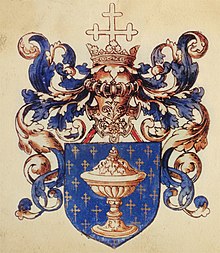
The Junta, Junta General, Juntas, or Cortes of the Kingdom of Galicia[1] was the representative assembly of the Kingdom of Galicia[2] from the 15th century, when it originated as an assembly for the constitution of hermandades (brotherhood), and until 1834 when the Kingdom and its assembly were officially disbanded by a Royal decree.
Initially the Juntas Generales del Reino de Galicia was an assembly where representatives of the three states of the Kingdom (noblemen, churchmen, and the commoners) met. But soon it followed the evolution prompted by the Kings in other representative institutions, such as the Cortes of Castile, so becoming monopolized by the bourgeoisie and lesser nobility (fidalgos), who controlled most of the local councils of the cities and towns of the Kingdom, and at the expenses of Church and nobility. From 1599 the composition of the assembly became fixed and reduced to just seven deputies, each one representing one of the Kingdom provinces, and appointed by the council of the province's capital —Santiago de Compostela, A Coruña, Betanzos, Lugo, Mondoñedo, Ourense, and Tui— from among its members. Other towns, namely Viveiro and Pontevedra, tried during the 17th and 18th century to regain a direct representative in the assembly, to no effect.
The Junta, whilst having no direct intervention in law making, could rise armies and taxes, conceding or denying the King's petitions on behalf of all the local powers of the Kingdom, and it could also petition the King himself, being recognized as the voice and representative of the Kingdom and the depositary of its will, traditions and rights. Notwithstanding, the King never consented on the petition of the assembly to meet at will, and from 1637 he decreed that the meetings of the assembly can only take place when in presence of one representative of the monarch, with voice, usually the Governor-Captain General of the Kingdom, so trying to maintain a tighter grip on the institution and its agreements.
References edit
Notes edit
- ^ De Artaza (1998:475-476)
- ^ From the 13th century united with the Kingdom of Castile under the same Crown.
Bibliography edit
- De Artaza, Manuel María (1998), Rey, Reino y representación. La Junta General del Reino de Galicia, Madrid: CSIC, ISBN 84-00-07779-2